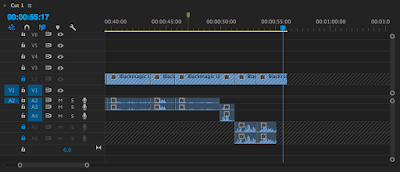During the editing process of our thriller, everyone in our group has had a chance to edit different moments and contribute ideas as to what angles would be best to use to portray the narrative and various moments where we reveal something within our piece.
 On our first day of editing we were advised to place all the shots that we thought were the best or best depict our narrative into our timeline so that when it came to making our first draft, it would be quick and easy to find the best shots rather than having to hunt through our rushes every time we want a new shot. However, for our group this seemed to be hared than with others mainly because our our repetitive dialogue so there were some occasions where we had to settle for the shots that we didn't like as much because they had a nicer moment of dialogue that hadn't necessarily been used yet. This did mean that we lost some time to searching through our rushes rather than getting all our footage together into our first draft. Sometimes there was more than one shot that we thought would work well in certain sections we would scroll across our timeline and experiment with each one to see which ones were most compatible together to clearly illustrate our narrative. Things that we decided were deal breakers between shots were things to due with continuity, framing, overlapping dialogue or moments where we broke the 180 degree rule.
On our first day of editing we were advised to place all the shots that we thought were the best or best depict our narrative into our timeline so that when it came to making our first draft, it would be quick and easy to find the best shots rather than having to hunt through our rushes every time we want a new shot. However, for our group this seemed to be hared than with others mainly because our our repetitive dialogue so there were some occasions where we had to settle for the shots that we didn't like as much because they had a nicer moment of dialogue that hadn't necessarily been used yet. This did mean that we lost some time to searching through our rushes rather than getting all our footage together into our first draft. Sometimes there was more than one shot that we thought would work well in certain sections we would scroll across our timeline and experiment with each one to see which ones were most compatible together to clearly illustrate our narrative. Things that we decided were deal breakers between shots were things to due with continuity, framing, overlapping dialogue or moments where we broke the 180 degree rule.
Another issue we had with some of our shots is that some had better audio but some had better framing. Unfortunately the ones with better framing were hard to put in because it's not like we could change the audio because the synchronization would be out of place. However, If the audio was very good and especially if it was something fresh that on the day the actors improvised, we would place different shots over the dialogue such as reaction shots and close ups of the other policemen. This not only allowed us to have a larger variety of dialogue but it also allowed us top reveal the extent of the police force that were called to this scene and also highlights the extent of the crime and hints into Molly's crime related past.
Our sequence is built around 5 main reveals; Molly at the edge, the knife, Detective Niland, Matty and the other policemen. Each one of these reveals increases the tension within the scene because the audience are being fed more and more information about Molly's crime. Some of these moments have allowed us to create very juxtaposing messages and allows the audience to see the intimidating situation Molly is in making them identify and sympathies with her as well as assisting us in how we reveal this information. There is one moment in particular that I feel does this and this is when Detective Niland says, 'everything's going to be alright'. This was a very unique moment in the dialogue because it wasn't planned but has created a remarkably contrapuntal moment because whilst we hear this audio, the is a shot when we see two police officers Fran and Manu holding guns to her. If we continued to make this a full scale feature film we would want the audience to be confused with their decision to sympathies with Molly because it gives both our narrative and Molly more depth.
I've found that as we progress through our narrative, our shots become shorter and more arbitrary to reflect the ever growing tension and fear within the scene. However, towards the end I feel that this turns around.Throughout the whole sequence our main character Molly holds a knife to the police and against the dying boy physically defending herself from anyone coming near her. Nonetheless, when she says the phrase "we leaped and we landed into the fresh fallen snow" she is defending herself mentally against Detective Niland. It isn't revealed within the opening sequence why this is a trigger to the detective but if this was a full length feature film, the audience would learn why he is effected by this. It's in this section when I feel that the shot duration becomes longer especially on Molly because it allows the audience to establish that the status is being manipulated and Molly gains the higher power by the end of the sequence.




